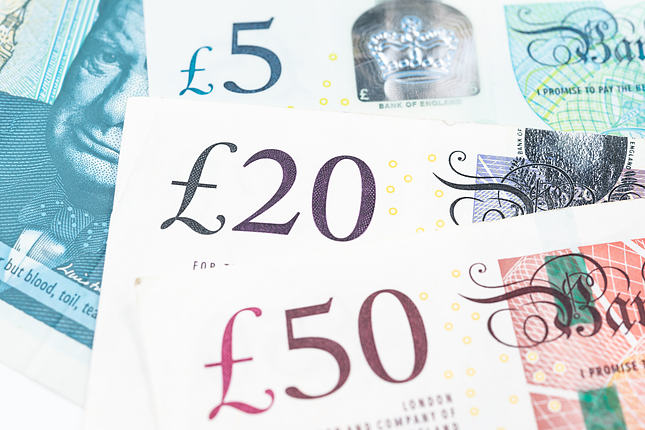GBP/USD Forecast and News
GBP/USD nears 1.2600 on renewed USD weakness
GBP/USD extends its rebound from multi-month lows and approaches 1.2600. The US Dollar stays on the back foot after softer-than-expected PCE inflation data, helping the pair edge higher. Nevertheless, GBP/USD remains on track to end the week in negative territory.
Latest Pound Sterling News
GBP/USD Technical Overview
The Relative Strength Index (RSI) indicator on the 4-hour chart stays slightly above 30, suggesting that GBP/USD could stretch lower before looking to stage a technical correction. On the downside, static support seems to have formed at 1.2480 ahead of 1.2400 (round level, static level) and 1.2340 (static level).
Looking north, first resistance could be spotted at 1.2550 (static level) before 1.2600 (static level, round level).
Fundamental Overview
Following Wednesday's loss of more than 1%, GBP/USD extended its slide on Thursday. After touching its weakest level since early May near 1.2470 in the Asian trading hours on Friday, the pair recovered to the 1.2500 area in the European session.
The Bank of England (BoE) maintained its bank rate at 4.75% after the December meeting, as expected. On a dovish twist, however, three members of the Monetary Policy Committee (MPC) voted for a 25 basis points (bps) rate cut. In its policy statement, the BoE said that they can't commit to when or by how much they will cut rates in 2025, due to heightened uncertainty in the economy. Pound Sterling came under bearish pressure following the BoE's policy announcements.
Early Friday, the negative shift seen in risk mood doesn't allow GBP/USD to gather recovery momentum. Growing concerns over a US government shutdown at the end of the day causes investors to adopt a cautious stance. Reflecting the sour mood, US stock index futures were last seen losing between 0.6% and 1% on the day. In case safe-haven flows continue to dominate the action in financial markets, the pair could stretch lower heading into the weekend.
Meanwhile, the data published by the UK's Office for National Statistics (ONS) showed on Friday that Retail Sales rose by 0.2% on a monthly basis in November. This reading came in below the market expectation for an increase of 0.5%.
In the second half of the day, the US Bureau of Economic Analysis will publish the Personal Consumption Expenditures (PCE) Price Index data for November. Investors are likely to ignore this data.
SPECIAL WEEKLY GBP/USD FORECAST
Interested in weekly GBP/USD forecasts? Our experts make weekly updates forecasting the next possible moves of the Pound-Dollar pair. Here you can find the most recent forecast by our market experts:

GBP/USD: Pound Sterling surrenders gains as US Dollar extends rally Premium
The Pound Sterling hit three-week highs against the US Dollar but then corrected. GBP/USD gears up for the Fed and BoE policy announcements, the grand finale for 2024. Pound Sterling buyers will likely stay reluctant below the key 200-day SMA at 1.2820.
GBP/USD Big Picture
GBP/USD Bullish Themes
GBP/USD BEARISH Themes
Latest GBP Analysis
Editors' picks

EUR/USD extends recovery beyond 1.0400 amid Wall Street's turnaround
EUR/USD extends its recovery beyond 1.0400, helped by the better performance of Wall Street and softer-than-anticipated United States PCE inflation. Profit-taking ahead of the winter holidays also takes its toll.

GBP/USD nears 1.2600 on renewed USD weakness
GBP/USD extends its rebound from multi-month lows and approaches 1.2600. The US Dollar stays on the back foot after softer-than-expected PCE inflation data, helping the pair edge higher. Nevertheless, GBP/USD remains on track to end the week in negative territory.

USD/JPY dips to test a previous top at 156.60 following hot Japanese inflation
The Yen trims some losses following higher than expected inflation levels in Japan. The hot inflation figures have increased hopes of a BoJ hike in January. Technically, the pair is correcting lower, after having reached strongly overbought levels.

Gold rises above $2,620 as US yields edge lower
Gold extends its daily rebound and trades above $2,620 on Friday. The benchmark 10-year US Treasury bond yield declines toward 4.5% following the PCE inflation data for November, helping XAU/USD stretch higher in the American session.

Crude Oil slides for a fifth day this week on Fed rate concerns
Oil prices set for a weekly loss in this final normal trading week of 2024. The hawkish message from the Fed on rate cuts for 2025 has scared investors away from commodities. The US Dollar Index did hit a two-year high for a third day this week and undergoes some profit-taking.
Majors
Cryptocurrencies
Signatures
GBP/USD YEARLY FORECAST
How could GBP/USD move this year? Our experts make a GBP/USD update forecasting the possible moves of the pound-dollar pair during the whole year. Don't miss our 2024 GBP/USD forecast!
2024 GBP/USD FORECAST
In the GBP/USD Price Forecast 2024, our analyst, Dhwani Mehta, notes there are plenty of unknowns and looming uncertainties that make it difficult to convincingly predict the course of the Pound Sterling against the US Dollar (USD) in the year ahead. On both sides of the Atlantic, increased odds of a recession, a dovish pivot in the monetary policies and general elections are foreseen as the key factors driving the GBP/USD price action next year, barring any unprecedented geopolitical risks. Read more details about the forecast.
GBP/USD witnessed a rollercoaster ride in 2023 but the Pound Sterling managed to preserve the recovery gains seen in the first half of the year to a 15-month high of 1.3142.
MOST INFLUENTIAL POLITICAL EVENTS IN 2024 FOR GBP/USD
BoE policymakers continue to push back against expectations of rate cuts next year. However, deteriorating economic performance prompted money markets to begin pricing in four 25 bps rate cuts starting from the summer, anticipating the key rate to be slashed from 5.25% to as low as 4.25% by the end of 2024. The first cut is expected as early as June, to 5.0%.
Even though the Bank of England largely shrugged off a 0.3% contraction in GDP for October, the prospect of a recession in the run-up to a 2024 national election remains high.
A general election is expected next year in the US and the UK, which could fuel intense volatility around the GBP/USD pair. Amidst looming inflation and growth concerns, the political developments on both sides of the Atlantic are likely to be closely followed.
Influential Institutions & People for the GBP/USD
The Pound VS Dollar can be seriously affected by news or the decisions taken by two main central banks:
The Bank of England (BoE)
The Bank of England is the central bank of the United Kingdom. Established in 1694 and privately owned in the beginning, the Bank was nationalised in 1946 so now is completely owned by the UK government. BOE's main reason to be is to maintain monetary and financial stability in the country. Some of its other tasks are producing secure bank notes, operating asset purchase facility and keeping the inflation low and stable. The bank is overseen by the Court, named used to reffer the board of directors, and is accountable to Parliament and the public.
BOE Official Website, on Twitter and Facebook
The Federal Reserve Bank (Fed)
On the other
FED Official Website, on Twitter and Facebook
Andrew Bailey
Andrew Bailey is Governor of the Bank of England since 16 March 2020. He was announced as the new Governor of the BoE on 20 December 2019. Bailey was born in Leicester in 1959 and graduated from Queens' College with a BA in History and a PhD from the Faculty of History, University of Cambridge in 1985. Before becoming the Governor of the BOE, Andrew worked at the Bank in a number of areas, most recently as Executive Director for Banking Services and Chief Cashier, as well as Head of the Bank's Special Resolution Unit (SRU). Previous roles include Governor's Private Secretary, and Head of the International Economic Analysis Division in Monetary Analysis.
Bailey on BOE'S Profile and Wikipedia
Jerome Powell
Jerome Powell took office as chairman of the Board of Governors of the Federal Reserve System in February 2018, for a four-year term ending in February 2022. His term as a member of the Board of Governors will expire January 31, 2028. Born in Washington D.C., he received a bachelor’s degree in politics from Princeton University in 1975 and earned a law degree from Georgetown University in 1979. Powell served as an assistant secretary and as undersecretary of the Treasury under President George H.W. Bush. He also worked as a lawyer and investment banker in New York City. From 1997 through 2005, Powell was a partner at The Carlyle Group.
Jerome Powell Fed's Profile and Wikipedia
BOE NEWS & ANALYSIS
ECB NEWS & ANALYSIS
About GBP/USD
The GBP/USD (or Pound / Dollar) currency pair belongs to the group of 'Majors', a way to mention the most important pairs in the world. The pair is also called 'The Cable', referring to the first Transatlantic cable that was crossing the Atlantic Ocean in order to connect Great Britain with the United States of America. This term originated in the mid-19th century, which makes it one of the oldest currency pairs.
Pound Sterling - US Dollar represents two economies: British and American (from United States of America). The Cable is a closely watched and widely traded currency pair where the Pound is the base currency and the US Dollar is the counter currency. For that reason, all the macroeconomic data related to the US and the UK affects the price of this pair. One of the events which affected most the volatility of the pound vs. dollar was Brexit.
Related pairs
EUR/USD
The EUR/USD (or Euro Dollar) currency pair belongs to the group of 'Majors', a way to mention the most important pairs in the world. This group also includes the following currency pairs: GBP/USD, USD/JPY, AUD/USD, USD/CHF, NZD/USD and USD/CAD. The popularity of Euro Dollar is due to the fact that it gathers two main economies: the European and American (from United States of America) ones. This is a widely traded currency pair where the Euro is the base currency and the US Dollar is the counter currency. Since the EUR/USD pair consists of more than half of all the trading volume worldwide in the Forex Market, it is almost impossible for a gap to appear, let alone a consequent breakaway gap in the opposite direction.
Normally, the EUR/USD is very quiet during the Asian session because economic data that affects the fundamentals of those currencies is released in either the European or U.S. session. Once traders in Europe get to their desks a flurry of activity hits the tape as they start filling customer orders and jockey for positions. At noon activity slows down as traders step out for lunch and then picks back up again as the U.S. comes online.
USD/JPY
The USD/JPY (or US Dollar Japanese Yen) currency pair belongs to the group of 'Majors', a way to mention the most important pairs in the world. This group also includes the following currency pairs: EUR/USD, GBP/USD, AUD/USD, USD/CHF, NZD/USD and USD/CAD. Japanese Yen has a low interest rate and is normally used in carry trades. This is the reason why is one of the most trades currencies worldwide. In the USD/JPY the US Dollar is the base currency and the Japanese Yen is the counter currency. The pair represents American (from United States of America) and Japanese economies.
Trading the USD/JPY currency pair is also known as trading the "ninja" or the "gopher", although this last name is more frequently used when referred to the GBP/JPY currency pair. The US Dollar Japanese Yen usually has a positive correlation with the following two pairs: USD/CHF and USD/CAD. The nature of this correlation is due to the fact that both currency pairs also use the US Dollar as the base currency, such as USD/JPY. The value of the pair tends to be affected when the two main central banks of each country, the Bank of Japan (BoJ) and the Federal Reserve Bank (Fed), face serious interest rate differential.